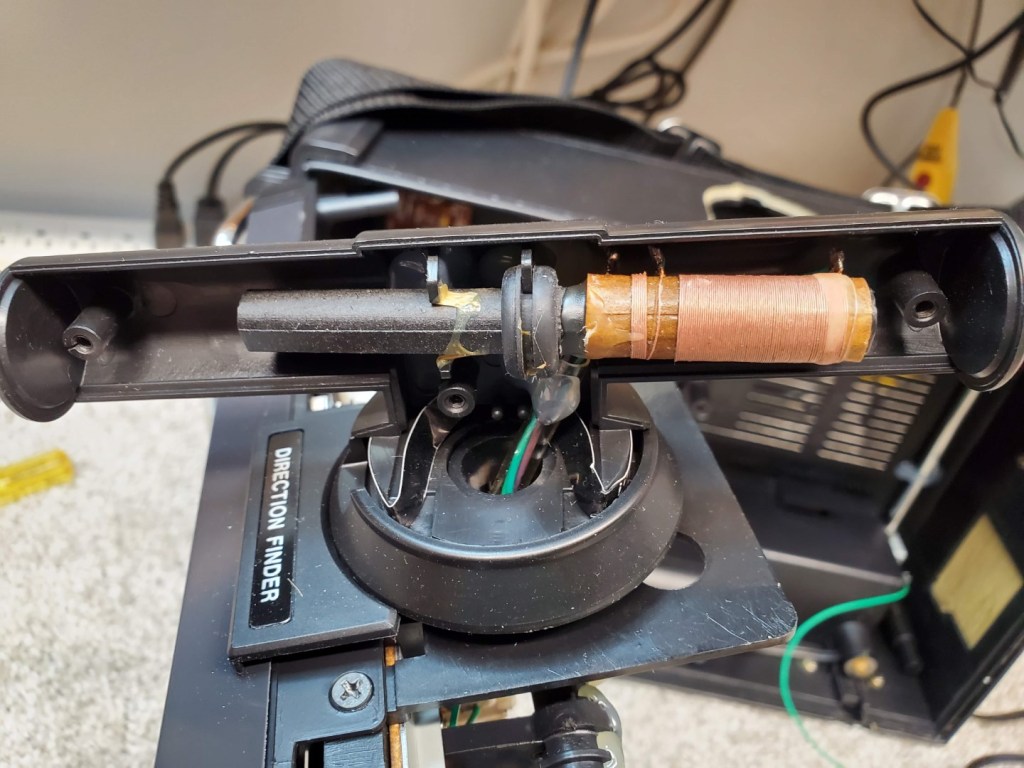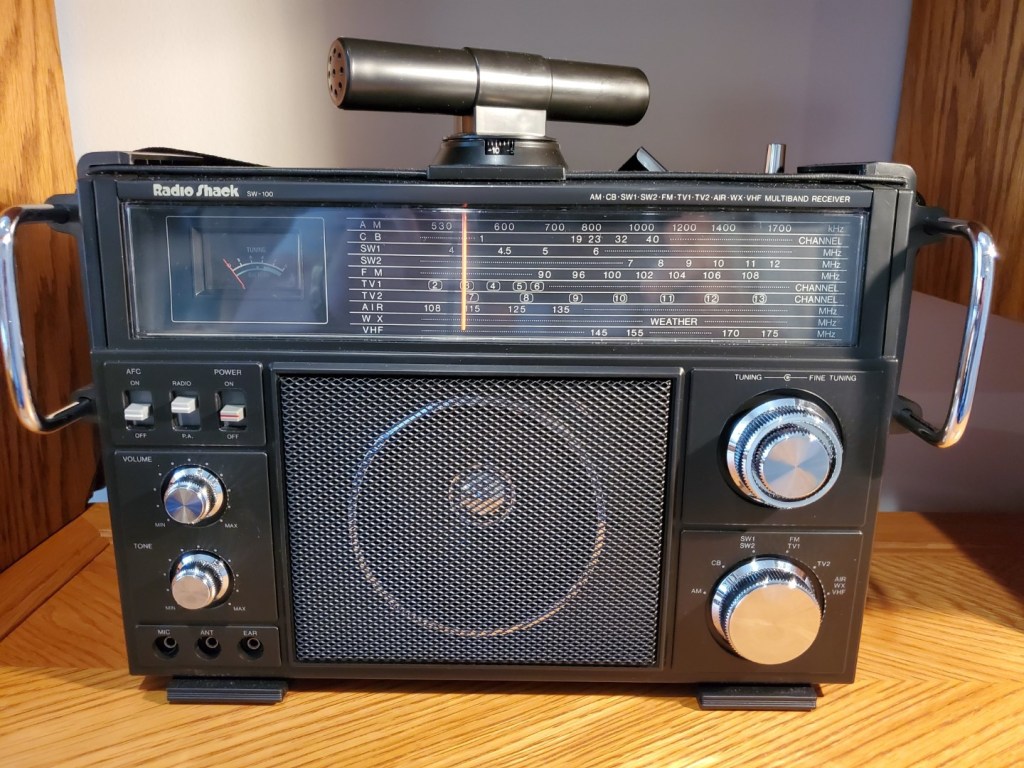Radio Shack SW-100 AM/FM/SW/CB/TV/Air/Weather Radio

The SW-100 (not to be confused with the much different DX-100) is a real step back in time…more so than many other radios of its era. While 1993 doesn’t seem like ancient history to me, this radio demonstrates just how much has changed since then, primarily because of its band coverage. In addition to AM/FM, SW and VHF (which includes Air & Weather) it also includes VHF TV sound which is no longer useable (since analog TV transmissions no longer exist) and Citizen’s Band which, while still in use, is not nearly as popular as it was 30 – 50 years ago. Normally I would not have chosen to buy a radio with these near vacant bands but a generous reader offered me the radio which was like new in its box with its owner’s manual so it seemed like an interesting candidate to evaluate. Radio Shack offered hundreds of radios of all descriptions ranging from its inexpensive and unique Flavoradios to higher quality rebadged radios made by Sony, Sangean and others with many made exclusively for the “Shack”. The SW-100 (stock No 12-649) was first seen in the Radio Shack 1993 Catalog (Page 31) and was available through 1998. Similar models were also available in under different names such as Rhapsody, Venturer and Waltham to name a few and there was even a version which added a cassette deck. The apparently similar model 12-795 debuted in the 1999 catalog (on Page 92) and was available through at least 2002. You can view the Radio Shack Catalog Archive here:

I must say that the SW-100 is an impressive looking portable. It features a rotating AM ferrite rod on top, large dial scales, a SW Fine Tuning knob, Signal/Battery Meter, a variable Tone Control, a SW Antenna Input, a Mic Input for use as a PA of sorts, Earphone jack and a generally sturdy feel. A look at the interior reveals solid construction with two ceramic variable tuning caps and a second ferrite rod antenna of good size…larger than the AM rotating rod on the top. This posed a mystery…what was this second ferrite rod for? Usually when a radio has two ferrite rods one is for longwave but the SW-100 has no longwave band. We’ll get back to that in a minute.
Initial Setup: As I said this radio looked brand new and was clearly used very little if at all, but I had two initial issues to deal with.

The first was a common problem I’ve seen with many older radios. Modern batteries must be a bit larger than the batteries of old because I found it nearly impossible to get the 4 D cells to go into the radio. I ended using a screwdriver to wedge them in…I literally could not get them in any other way. Even using the screwdriver, it was a challenge. Perhaps today’s batteries vary a bit in this regard as well…I don’t know.

The other issue was a sticking meter. In fact, I initially thought it was dead because it wouldn’t move at all, either as a signal strength meter or as a battery level indicator. I checked its continuity with a VOM and when I did that it jumped to half scale and stuck there…it was clearly binding. I had seen this with a Sony meter before and knew what do to. I removed the meter which was easy…two screws with no further disassembly necessary, and found it was held together by scotch tape (again, not uncommon). I removed the tape and separated the case, then moved the meter’s needle manually and it began to bounce a bit but it was still sticking. There was a small screw which retained the needle mechanism (not the zero-set screwdriver adjustment) and found that by loosening it a half turn the meter was freed up and now worked normally. Since this is a known issue with some other meters, I can guess the plastic meter case must somehow have changed dimensionally a bit with age. I guess we all do….

Back to that ferrite rod mystery: After some experimenting, I discovered that the internal ferrite rod is used for SW which was quite a surprise…this is very unusual, although I do have one European radio (an ITT-103) with an internal “frame” antenna said to be used for the lower SW bands on local signals, although that radio also uses its whip antenna for enhanced SW reception. Generally speaking, ferrite rods become less efficient once you get above the AM broadcast band. Why the designers chose this approach is still a mystery…it would seem that the telescoping whip would be more effective…and cheaper as well. The ferrite rod is not bad…when I compared weak daytime signal SW reception it was somewhat less sensitive than the typical portable using a whip antenna but it was usable, and at night with several stronger signals it was even better. But still…one has to wonder why.
(BTW – I found an excellent service manual from vintagemanuals.com – email them at sales@w7fg.com or call 865-309-5073).

AM with the top mounted swiveling antenna was the SW-100’s best band with respectable performance and sound quality. Radios with swiveling AM antennas are a joy to use and you can’t overlook the coolness factor they add. I also really liked the long well-marked AM dial which provided reasonably good accuracy for an analog radio. As you can see the AM ferrite rod is not as large as it could/should have been but nevertheless the SW-100 rated *** on the AM Mega Shootout list after the radio was aligned..as found it ranked **1/2.
FM was typical for a portable radio of this vintage, with pretty good sensitivity but poor selectivity. With today’s overly crowded FM dial in many areas you will miss many FM stations which modern, more selective FM radios can separate.
The VHF Band which includes Air Band and Weather Band is also typical for the era with less sensitivity than today’s radios with more advanced technology can offer. I was able to tune in the strongest of the several NOAA Weather stations I receive here (I can get 4 of these but only one is fairly strong) but there was no trace of the weaker ones. Air Band was similar – stronger signals were receivable but this is not your best choices for VHF, which also suffered from breakthrough of some area FM stations.
Citizens Band worked pretty well. Oddly, this band, which is part of the SW spectrum between 26.965 – 27.405 MHz does use the whip antenna (as does the VHF band) and I immediately heard a conversation that was coming in pretty well.
AS for the now defunct TV bands I can only guess that it must have been interesting to be able to tune into channels 2-13 to listen to in a day when there were fewer TV sets and no portable video devices in our lives.

Conclusion: In today’s world the Radio Shack SW-100 shows its age with outdated band coverage and lackluster FM and VHF performance. On the other hand, it offers very good AM performance with a nice analog tuning feel, that nifty rotating AM antenna and pleasant audio. It’s a very nice AM radio and I will definitely take it out for a spin now and then. It is also well made – my little-used sample is still pretty well aligned and other than that sticking meter seems ready to go for another 30 years. It was an interesting look back in time and it certainly is a very nice display radio. I thank the reader who donated it to me!
You must be logged in to post a comment.